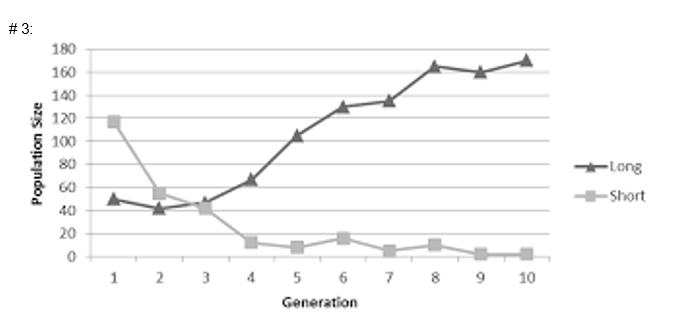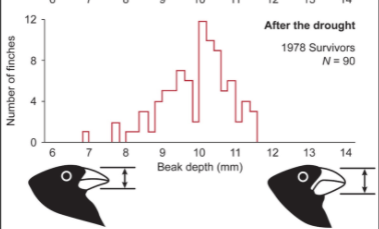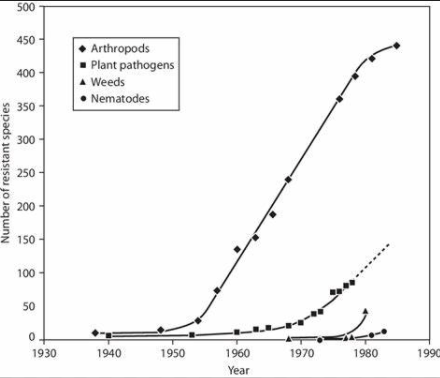Scientists have studied the fossilized shells of prehistoric, single-celled marine organisms. Some of these shells were thin, which indicates that the organisms lived in very warm ocean water. Such evidence indicates that the climate during this time may have been...
A. tropical.
B. arctic.
C. mountainous.
D. freshwater.
A. tropical

What adaptation helps protect a cactus against herbivores?
Thorns!
What is a process where individuals that have certain inherited traits tend to survive and reproduce at higher rates than other individuals because of those traits?
Natural Selection
According to this graph, which line represents organisms that have the greatest fitness?
Blue!
What is the term used for a trait that is helpful and allows the organism to have higher fitness?
Adaptation

Which fossil most likely represents the oldest form of life?
Fossil # 4
A population of green iguanas lived on a tropical island. Originally, most of the iguanas had feet without webbing between their toes and a long round tail. A few iguanas had webbed feet and a short, flat tail. As the years passed, the island became smaller and smaller because of flooding. Even the land areas were dotted with ponds and pools. The iguanas had a hard time finding the food they normally ate. To survive, the iguanas had to swim from island to island to find food.
How would you expect the iguanas to look many years after the island flooded and food became harder to find?
More Webbed Feet!
Natural selection is a mechanism for ______ to occur! This is when the gene frequency shifts within in a population.
evolution
According to the graph, which trait would be considered an adaptation from year 5 to year 10?
Dark coloring
When would we consider a species a population?
When they live in the same location!
What can scientists infer about a specific period of Earth's history if many fossils were discovered from nitrogen-breathing organisms?
A. the atmosphere lacked nitrogen
B. only fish lived during that time
C. the dinosaurs used all the oxygen
D. the atmosphere had lots of nitrogen
D. the atmosphere had lots of nitrogen

Four species of finch arrive on a newly formed Galapagos island which is covered with cacti growing in loose, dry sand. The cacti have honey-filled flowers and tiny seeds. The theory of evolution by natural selection would probably predict that ____________________ would most successfully survive, because _________________________.
A. Finch # 1; its large size makes it the fittest.
B. Finch # 2; it will probably be able to dig up worms with its bill.
C. Finch # 4; its tiny pointed bill is the best adapted to sip nectar.
D. Finch # 3; animals with intermediate traits tend to have higher survival rates in new places.
C. Finch # 4; its tiny pointed bill is the best adapted to sip nectar.
Changes in organism's DNA sequence! These are not always negative and can allow for greater genetic variation within a population.
Genetic Mutation
According to this graph, which leg length had greater fitness in the first year? Look at Graph # 3 on your handout.

Short
The different traits seen in a population are caused by...?
Genetic Variation OR differences in the DNA sequences
According to the following sample fossil record, at what layer was the environment no longer aquatic?
Layer B

Horses are much larger today than their two-foot tall ancestor, mesohippus. Geologists believe the change in size was the result of changing environments, from tropical forests to a grassland habitat.
Larger size would be an advantage for survival in this new habitat because...
A. larger horses could reach the leaves that grow high on trees.
B. larger horses could climb easier than the shorter horses.
C. the larger horses were better camouflaged than the smaller horses.
D. larger horses had longer legs and could run faster to escape predators.
D. larger horses had longer legs and could run faster to escape predators.
All the genes, including all the different alleles for each gene, that are present in a population at any one time!
Gene Pool
According to graph # 4, which beak size was least fit for the new environment?

Around 7 mm
What are preserved remains or traces of an organism that lived in the past?
Fossils
A limestone rock is found in an Arizona desert. The limestone is gray and has a fish fossil. What can scientists learn about the environment from the limestone?
It was once underwater!
A population of bacteria is treated with an antibiotic. Because of variation in the population of bacteria, what is a possible outcome of the treatment?
A. The population will increase rapidly.
B. All of the bacteria will be resistant to the antibiotic.
C. The population will be better able to obtain a food source.
D. Some of the bacteria may be resistant to the antibiotic and survive.
D. Some of the bacteria may be resistant to the antibiotic and survive.
How often a particular gene occurs in the population is known as...
Gene Frequency
According to the Graph # 5, which population of organisms became the most resistant to the insecticide sprayed?

Arthropods
When is your test and how can you earn 5 bonus points?